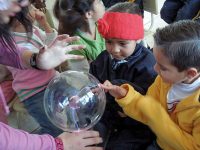
 Riken Riken |
||
|
In early January, Nature published two papers (I and II) on mature cells that could acquire embryonic properties when subjected to an acid bath. The described process, called STAP (Stimulus-Triggered Acquisition of Pluripotency) opened up new possibilities in cell reprogramming. Embryonic stem cells have the ability to become any type of cell, which makes them particularly important in tissue regeneration. Since Japanese scientist Yamanaka obtained induced pluripotent cells (IPs) – adult cells engineered to acquire the potential to become any cell type – in 2006, cell reprogramming research experienced a huge boost. If the results were confirmed, the work with STAP cells, led by researcher Hakuro Obokata and signed by different members of the Riken Brain Science Institute in Japan and the Brigham & Women’s Hospital/Harvard Medical School, would set a new milestone in the field. The news was therefore enthusiastically received by the press: «Stressing adult cells to achieve embryos» (El Mundo, 30/1/14), «Adult cells transformed into stem cells using acid» (El País, 29/1/14), «Scientists discover a new technique of cell reprogramming» (La Vanguardia, 29/1/14) or «The new era of regenerative medicine» (ABC, 31/1/14) were some of the headlines. First suspicions The work, however, was never confirmed. Instead, it was quickly questioned due to different inconsistencies in the images and some of the information provided. So, two weeks after its publication, even the Riken Institute announced an internal investigation. Teruhiko Wakayama, cloning specialist and co-author of the project, advised the temporary withdrawal of the papers. In contrast, another author – Charles Vacanti, from Harvard Medical School – defended that some errors did not invalidate the study and that STAP cell reprogramming remained a field to develop. The internal investigation at Riken pointed to Obokata as responsible for partial manipulation on two points of the work. The researcher, for her part, has already announced her desire to appeal the report. Meanwhile, a researcher appeared who claims to be getting results with an update of STAP protocol published by Vacanti. Despite scepticism among scientists and media, the issue does not seem to be easy to close. The pull of conflict While in other cases the discovery generates more attention that the recantation, in this case the scientific controversy – that took place in several press conferences – has been followed intensely by the media. There are also other factors such as the implications of the discovery or the fast pace of events, which may have contributed to an increase in coverage. Doubt followed the initial interest, as these headlines show: «The latest development in stem cells under suspicion» ( El País (17/2/14) or «Doubt cast on the latest discovery in stem cells» (El Mundo, 19/2/14). Weeks later, they demanded the withdrawal of the papers: «The authors call for the withdrawal of the latest study on stem cells» (El Mundo, 10/3/14). Finally, the report of the investigation conducted by the Riken Institute was picked up by most of the newspapers, emphasising the word fraud in the headlines: «A Japanese research centre admits a ‘fraud’ in the latest major study on stem cells» (El Mundo, 1/4/14), «Latest papers on stem cells withdrawn on the basis of fraud» (El País, 1/4/14), «Fraud on the latest great breakthrough on stem cells confirmed» (ABC, 2/4/14). Learning from controversy In short, Has this latest scientific controversy helped us to learn anything? First, to remember something as obvious as verifying the data before announcing a breakthrough. The pressure to publish in scientific journals cannot lead us to accept unverified protocols that do not allow for the reproduction of results. It seems not appropriate for journals, who are authoritative sources for both scientists and journalists, to be seduced by shocking papers that will later need recantation or even withdrawal. In this case, precipitation seems to have driven the entire process since it started being covered: the initial press conference, the publication, the almost immediate questioning or the report that quickly pointed to Obokata as the culprit in all this mess. In just over two months, the study went from breakthrough to fraud. Impatience is never a good counsellor, and this case proved – again – that the pressure to publish should not drive scientific research. Lucía Sapiña. The Two Cultures Observatory. |
«Given the importance of the discovery, the media quickly covered the study»
«In this case, the scientific controversy has been followed intensely by the media»
«The internal investigation at Riken pointed to Obokata as responsible for partial manipulation on two points of the work»
|
|





